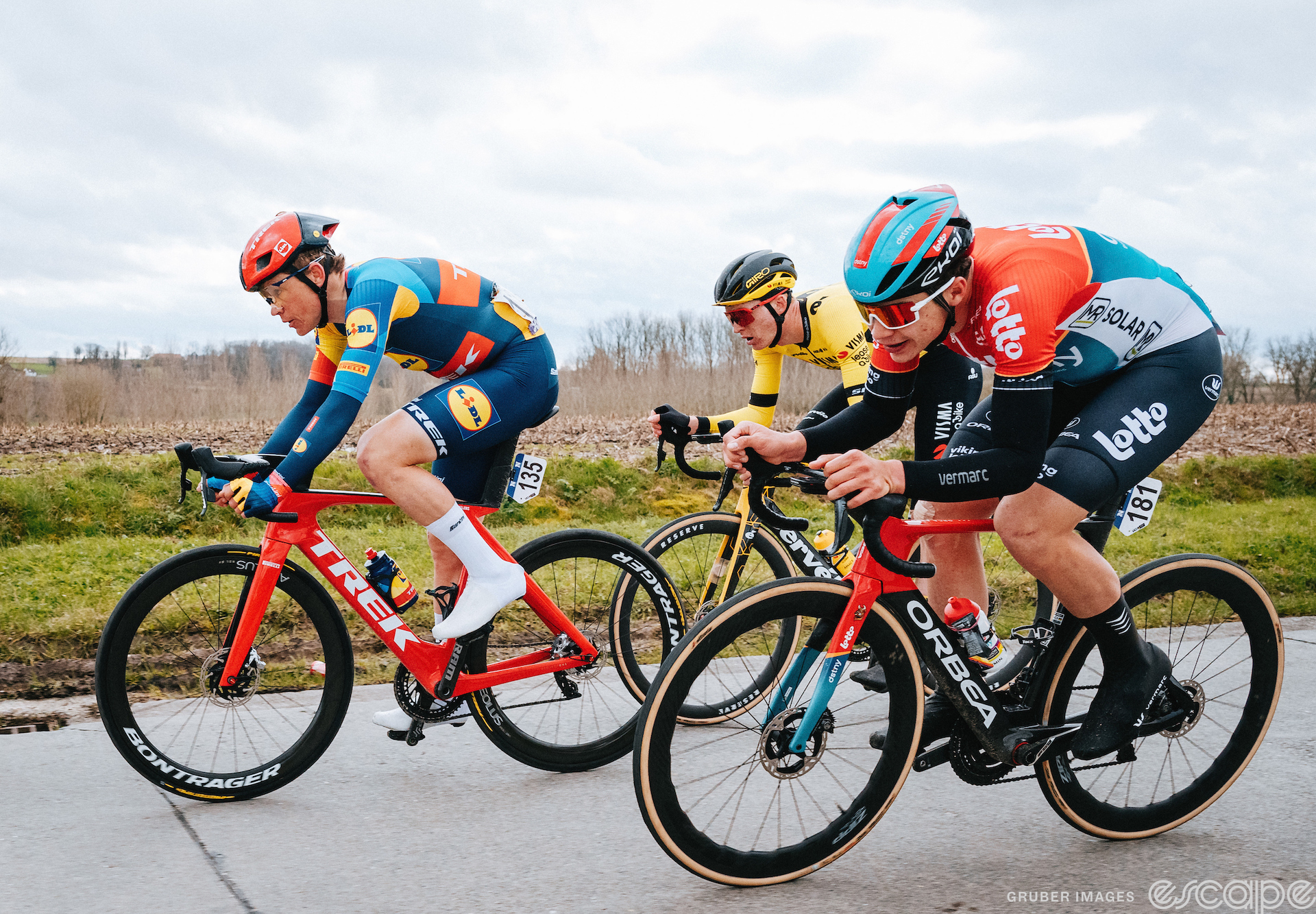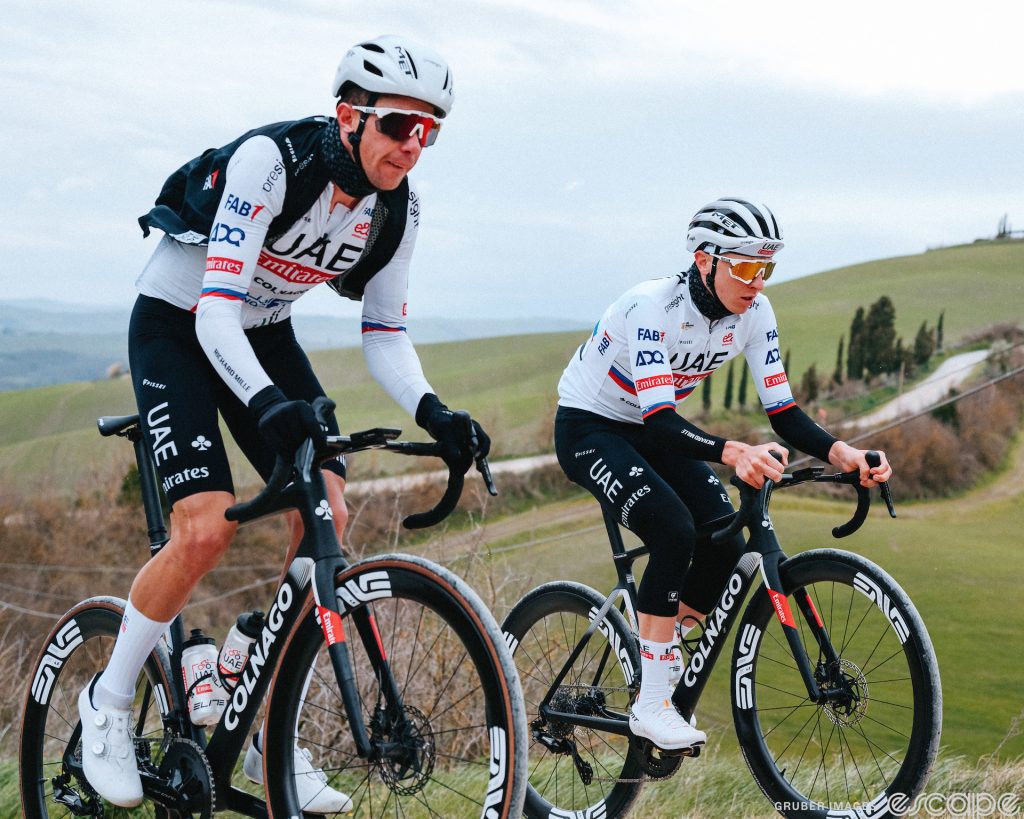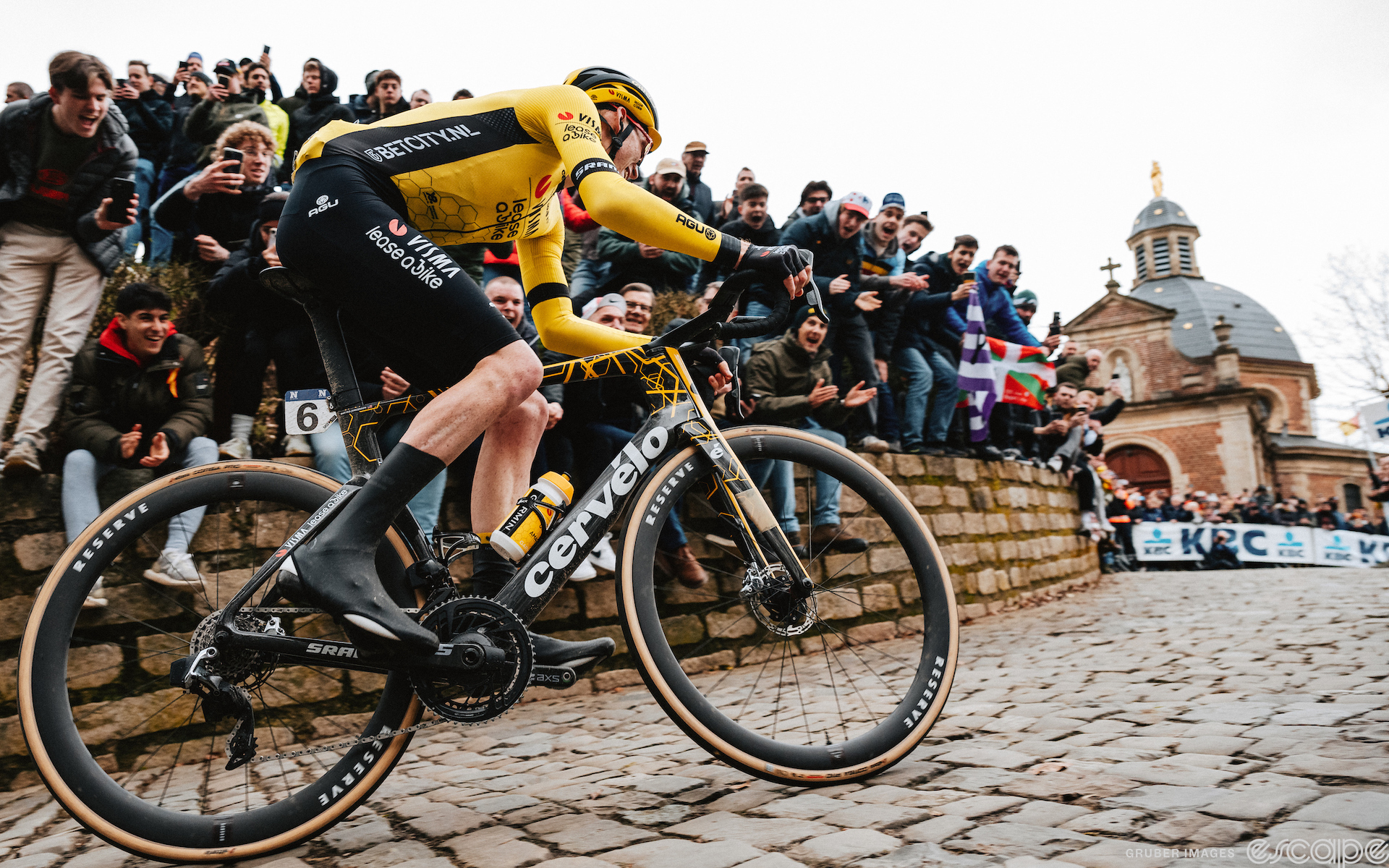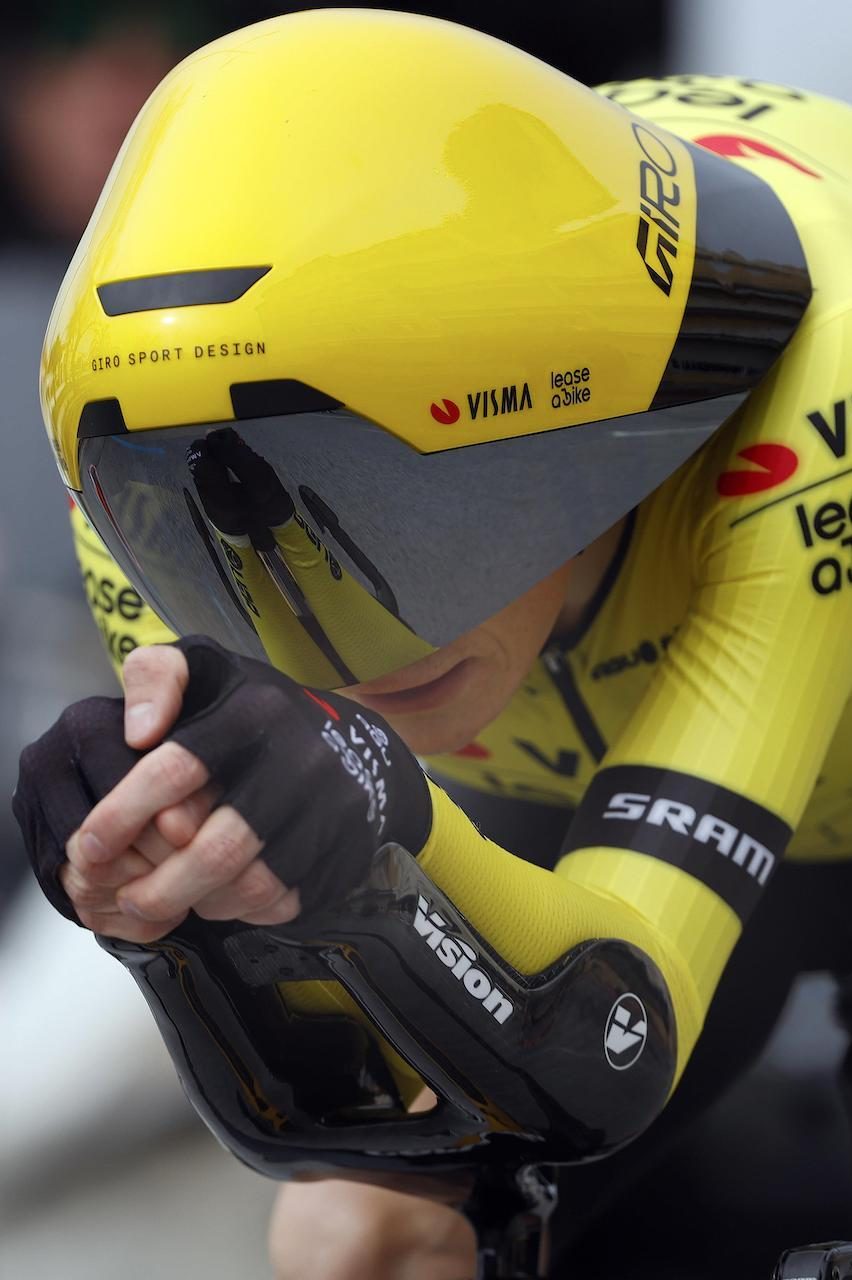Editor’s note: an earlier version of this article incorrectly described the relationship between power and aerodynamic drag. While drag increases at the square of the speed, power required to sustain that velocity rises at the cube of the speed. Additionally, while the term “exponential” was used in a colloquial sense, that is now changed to “non-linear” to reflect that exponential has a precise mathematical definition that does not fit here. The author’s math-major mom is appalled by the errors.
I’m not sure exactly when the tipping point was: when riders began regularly wearing skinsuits for mass-start races, or POC introduced its first Tempor time-trial helmet with its flared wings and cetacean-like blowhole, or socks began getting ridiculously tall.
But the unveiling of Giro’s newest time-trial lid on Monday at the opening stage of Tirreno-Adriatico feels like the final piece of evidence I need to acknowledge a reluctant truth: WorldTour kit and bikes are haute couture now.
I should add that I don’t mean that as a criticism. But the new Giro Aerohead 2.0 underlines how far afield WorldTour technology has gotten from the lived experience of everyday drop-bar riders. It is now as relevant to many of us as Paris Fashion Week is to what hangs in your closet.
Without getting into “woman yelling at cat” levels of blame, this is mostly due to a focus on aerodynamics, which is itself a convergence of two forces: the explosion of awareness the past decade on the specific importance of aerodynamics in a racing environment, and the explosion of computing power and capability that has made experimenting with improvements to aerodynamics far more accessible and affordable. The resulting learning curve has been steep. If Ronan Mc Laughlin’s body of work makes nothing else clear (and his work does far more than that) it’s that a lot of aero gospel from even a decade ago is now understood to be quite a bit less gospel-y than we’d thought. The church of CdA has no Pope.
When the industry understood less about aerodynamics, and iterative product development relied heavily on costly physical prototypes and wind tunnel testing, it proceeded more cautiously and mostly took cues from established research; a good example is how, for much of the early aero boom, the bike industry used tube and rim profiles taken from the library of NACA-spec airfoils.
But as the body of knowledge grew, the industry began to realize that what is optimal for, say, generating lift under a wing at airplane takeoff velocities wasn’t always relevant to racing bicycles. And as the ability to model low-speed aerodynamics fostered that knowledge, companies could, for lower cost, test handfuls or even dozens of designs in a virtual sandbox to find ones that were the most promising to pursue further.
That included the ability to explore shapes and product designs that might seem outlandish – ones too speculative to build and test in a world before sophisticated computational fluid dynamics (CFD) software became as widely available as it is today. Brands vary in their employment of CFD, but you can bet it played a central role in the new Giro helmet and countless other aero products – Trek doesn’t punch a hole in the seat tube of its seventh-generation Madone on merely a hunch that it’s faster.

The result, you can see, literally, right there on Jonas Vingegaard’s head at the top of this story. And it’s not just about a single helmet or even TT helmets as a group. GCN notes that in nearly a decade of measuring them, bike weights in the pro peloton have increased, not decreased, and only partly due to the widespread adoption of disc brakes; aerodynamics is the other major cause, as teams and bikemakers now understand that the benefit of lowering CdA, in terms of reducing physiological workload, far outweighs the extra grams, if you’ll pardon the pun.
This is all fantastic advancement in equipment engineering, and none of what I’ve just written is much news to anyone who’s been paying close attention to racing and road-specific bike technology the past decade. But for far longer than that, bike and equipment brands’ sponsorship of elite-level cycling teams is built on the premise that what pro racers ride is relevant to recreational riders’ needs. The gear that is good for them is good for us, both directly in a one-to-one ratio at halo price points, and in some fuzzier expression of trickle-down engineering at lower ones. That premise no longer holds.
In specific examples, this has been true a long time. The WorldTour was among the last major redoubts of tubular tires, for instance, long after the mass-market takeover of clinchers and, now, tubeless. But the disconnect has now grown to encompass almost every piece of gear in the sport. Aero frames and wheels are now ubiquitous in the WorldTour, but the best sellers for brands like Trek, Specialized, and Giant aren’t the Madone, Tarmac, or Propel, but the more versatile (and comfortable) Emonda and Domane, Aethos and Roubaix, and TCR and Defy.
It would be a shock today to see a WorldTour rider show up to the start line in separate jersey and shorts, but except at races, you won’t see skinsuits on the local riding scene. Even gearing has diverged; because of their speeds and power, WorldTour riders will regularly run 56- or even 58-tooth big chainrings in certain races; the largest stock configuration Shimano offers of its 9200 Dura-Ace crankset is a 54/40 combo, and the once-unusually small 50/34 is now standard on many retail road bikes.


WorldTour aerodynamics are applicable to at least some amateur racing. Invariably, any launch of a new product with claimed aerodynamic benefits comes with a few statistics about how many watts are saved compared to its predecessor or competitors. The asterisk is that this data almost always derives from testing at a benchmark speed of 48 km/h, or 30 mph (up from the prior benchmark of 40 km/h).
It’s rare for even good amateur fields to average that even over shorter distances. The recently concluded Valley of the Sun stage race in Arizona always attracts a solid field, and the average speeds for the men’s Pro/Cat 1, Cat 2, and Cat 3 road race fields, over courses ranging from 62 to 94 miles (100 to 151 km) were all right around 40 km/h. Fast. But not quite WorldTour fast.
That matters because wind resistance is non-linear; aerodynamic drag rises at the square of the speed, while the power required to overcome it rises at an even higher level, at the cube of the speed. For a solo rider with an average CdA on flat asphalt in calm conditions, jumping from a fast 32 km/h to 40 km/h requires a roughly 80% increase in power output. And so the aerodynamic benefits claimed for products that are based on a 40 or 48 km/h testing environment drop by similarly exponential levels as your speed decreases from those benchmarks. On the flip side, consider that the drag is based on the rider’s speed plus that of any headwind, so if you’re riding 20 km/h in a 20 km/h headwind, your total “air speed” is still 40 km/h.
Sure, it’s not necessary to average those speeds to get some benefit, but lower speeds – whether on average or at a given point in a ride – necessarily mean less benefit. Gear designed for WorldTour racers is optimized for WorldTour speeds and let’s face it, if you could hold those riders’ wheel, you’d be in the WorldTour.

As a tangent, but a relevant one, it’s also worth pointing out that, for TT or triathlon helmets, the actual benefit of a given helmet varies depending on the rider’s position; it’s for that reason that Lidl-Trek – because Trek does not make a TT helmet – lets its riders pick which brand and model is best for each individual, with the result a wide array of choices. That underlines how much of aerodynamics is down to your position on your bike, meaning a Pilates class might be a better marginal gain than a new skinsuit.
All that information is in the context of racers, who make up a small subset of recreational riders overall. If you don’t race, chances are your total air speeds at any given moment are considerably lower still, meaning aero-focused technology benefits you quite a bit less than it does even amateur racers.
And that is before we even consider whether aerodynamics matters at all to a non-racer. I’ll be the first to grant that I enjoy riding more when I’m fit and going fast. But for non-racers, that feeling is often subjective; when climbing, the sensation of acceleration from a light, stiff bike, with shallow-depth wheels that offer quick, snappy spinup can be more meaningful than doing the same climb on faster, aero gear that feels slower. This is literally the design brief behind the Aethos. To put it a different way, if your numbers go up are you having more fun?
The TL;DR is that we are now a long, long way from the old “Race on Sunday, sell on Monday” era.
And I’d argue that, in many ways, that’s a good thing. As WorldTour equipment achieves a kind of escape velocity from the gravitational pull of everyday riding, the bike industry has also been freed of the need to tie them together. The rise of gravel and mixed-surface riding means that most brands have a continuum of bikes that ranges from pointy-end-of-the race aero stuff to what are basically drop-bar hardtails for trail riding. Wheels, tires, gearing, clothing, helmets: all feature far more choices than even a decade ago. Somewhere in that spectrum is the gear that’s right for you; it’s just probably not what Jonas Vingegaard is riding.

Instead, the WorldTour has become a kind of distinct sub-species of even road cycling, much like haute couture is distinct from the ready-to-wear lines from the very same fashion houses, which themselves are set apart from mass market apparel. We can discuss the aesthetic appeal (or repellancy) of Giro’s TT lid in much the same way as fashion fans and media critically appraise the spring collections of Balenciaga or Dior, without thinking much about how it might affect what you buy from your favorite off-the-rack retail brands.
This is more than mere metaphor. Haute couture, for all its grounding in artistic expression, is subject to the same kind of rigidly codified rules as racing equipment. In fashion, the UCI is the Chambre Syndicale de la Couture, which decrees that haute couture can only be practiced if the label employs at least 15 full-time workers in the atelier, biannually presents a collection of at least 50 pieces, and offers those pieces to the public as bespoke clothing with multiple fitting sessions – that last point being remarkably similar to the UCI’s rules requiring manufacturers to offer for sale to the public any gear raced in UCI-sanctioned events.
Those rules, as Ronan has written, are increasingly creaky and irrelevant, as manufacturers skirt the spirit of them with prices, lead times, and purchase processes that are so grotesque they make owning, say, a Team GB Hope track bike a practical impossibility. Those rules no longer work as intended, if they ever did, and as the WorldTour diverges from the majority of the retail market, it’s worth asking whether there’s reason for them to exist at all. Instead, the UCI is in a lather, banning headsocks and promising a review of TT helmet design, of unspecified scope and intent, on an unstated timeline.
Giro’s Aerohead 2.0 is a remarkable feat of science, engineering, and technology. I respect the hell out of what the brand did even if the product itself is irrelevant to my own needs and anathematic to my personal aesthetic. I look forward to reading Ronan’s future reporting on it – learning how and why it works and how Giro came to create such a visually distinctive lid.
But I can do that at a critical distance, assessing it in the specific context of WorldTour racing. I’m fascinated by it, even as I’d no more wear it on my next ride than I would don a Chen Peng puffer for my next morning of skiing.
What did you think of this story?


